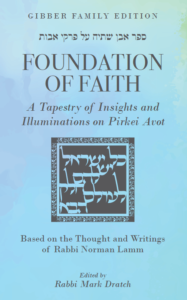Excerpted from Foundation of Faith: A Tapestry of Insights and Illumination on Pirkei Avot based on the Thought and Writings of Rabbi Norman Lamm, The Gibber Edition, edited by Rabbi Mark Dratch, co-published with Ktav Publishing
The world was created with ten utterances. What does this teach us? Certainly, it could have been created with a single utterance. However, this is in order to make the wicked accountable for destroying a world that was created with ten utterances, and to reward the righteous for sustaining a world that was created with ten utterances.
Ten
This positive value of confrontation has been expressed in a beautiful symbolic manner by a great sage of modern times. Our rabbis of the Talmud categorized the entire period from Creation to Sinai, the revelation of the Torah, as tohu, chaos. What they meant was that the world as created by God was only physically complete but had not actualized its moral potential. It came of age morally only with the giving of Torah at Sinai. Now, what is the catalyst that helped in this transformation? What is it that helped the world overcome its amoral character and rise to the level of Sinai? The great Gerer Rebbe identifies this catalyst as the Ten Plagues of which we read today. In epigrammatic fashion, he tells us that the transition from asarah ma’amarot to aseret hadibrot was effected by eser makkot. The world was created through Ten “Words” of God, such as “Let there be light,” etc. Creation is therefore symbolized by the Ten Words, and its moral maturity by the Ten Commandments. But it was the Ten Plagues that made this possible. The confrontation of Moses with Egypt succeeded in uprooting the corruption of Egypt, exposing the vacuousness of its nefarious paganism, and therefore allowing Israel to emerge from within it and receive the Torah. Without the Ten Plagues, the Ten Words would never have become the Ten Commandments.
Ten Words
Furthermore, we must be not only discriminating in our words, but sparse as well. Our words must be few and scarce. In all of Judaism, the principle of Kedushah is protected from the danger of over-familiarity. When people have too much free access to an object or a place, they gradually lose respect and awe for it. That is why the reader of the Torah will use a yad, a silver pointer. That is not used for decorative purposes. It is because of the Halakhah that kitvei kodesh metamin et hayadayim – that we are forbidden to touch the inner part of the Torah scroll. The reason for this is a profound insight of the Torah into human nature: if we are permitted to touch it freely and often, we will lose our reverence for it. The less we are permitted to contact it, the greater our respect for it. Similarly, the Holy of Holies in the Temple in Jerusalem was preserved in its sanctity by our tradition when it forbade any person other than the high priest to enter its sacred precincts; and even he might not do so except for one time during the year – on the Day of Atonement.
And so it is with words. The more we use, the less they mean. When our rabbis investigated the first portion of Genesis, they discovered that the world was created by asarah ma’amarot, ten “words.” Only ten words to create an entire universe! And yet our rabbis were not satisfied. And so they asked, “Could not the world have been created with only one word?” Why waste nine precious words? Indeed, for with words, quantity is in inverse relationship to quality. If there are so many words that you cannot count them, then no individual word counts for very much.


